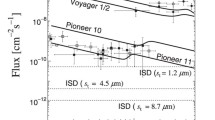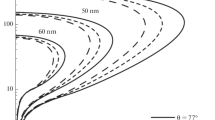Abstract
As a geoengineering strategy to attenuate the solar insolation and offset the impacts of global warming at the polar regions, this study proposes a Sun-pointing vertical Earth ring comprised of dust grains to shade mainly the Earth’s poles and to reduce climate change at the polar regions. A dust ring from 1.1 to 1.17 Earth radii passing above both poles of the Earth is designed, taking into account the effects of solar radiation pressure and the Earth’s \(J_2\) oblateness perturbation. Perturbations including atmospheric drag, third-body gravitational forces and shaded regions are neglected. A family of circular polar orbits, with inclinations about \(98^{\circ }\), is considered for the passive cloud of particles with radii less than 50 \(\mu \hbox {m}\). We state that the coupled effect of solar radiation pressure and \(J_2\) perturbation in the orbital dynamics of small particles is essential to ensure that the side of the dust ring will be pointing to the Sun. An analytical ring shadow model is used to evaluate its performance and to estimate the mass of the ring. The results of this study shows that the attenuation of solar isolation at the polar regions is about twice the attenuation computed in the rest of the regions of the Earth. Finally, an estimate of about \(5.5 \times 10^{12}\) kg of material is computed as the total mass required to offset the impacts of climate change at the Earth’s poles.















Similar content being viewed by others
Notes
https://www.zenithcrusher.com/en/products/xzm-ultrafine-mill.html/, Last accessed 05 Jan 2021.
References
J.C. Comiso, J. Clim. (2003). https://doi.org/10.1175/1520-0442(2003)016<3498:WTITAF>2.0.CO;2
T.R. Karl, K.E. Trenberth, Science (2003). https://doi.org/10.1126/science.1090228
J. Blunden, D.S. Arndt, Bull. Am. Meteor. Soc. (2012). https://doi.org/10.1175/2012BAMSStateoftheClimate.1
IPCC, Climate Change 2013: The Physical Science Basis (Contribution of Working Group I to the Fifth Assessment Report of the Intergovernmental Panel on Climate Change, 2013). https://www.ipcc.ch/report/ar5/wg1/. Accessed 01 Nov 2020
USGCRP, Impacts, Risks, and Adaptation in the United States: Fourth National Climate Assessment, Vol. II (U.S. Global Change Research Program, 2018). https://doi.org/10.7930/NCA4.2018. Accessed 01 Nov 2020
M.V. Guarino et al., Nat. Clim. Change (2020). https://doi.org/10.1038/s41558-020-0865-2
L. Cheng et al., Sci. Adv. (2017). https://doi.org/10.1126/sciadv.1601545
J.S. Hoffman et al., Science (2017). https://doi.org/10.1126/science.aai8464
J.A. Church, N.J. White, Surv. Geophys. (2011). https://doi.org/10.1007/s10712-011-9119-1
A. Dutton et al., Science (2015). https://doi.org/10.1126/science.aaa4019
Human Settlements on the Coast (2020). http://www.oceansatlas.org/subtopic/en/c/114/. Accessed 01 Nov 2020
D.W. Keith, Annu. Rev. Earth Planet. Sci. (2000). https://doi.org/10.1146/annurev.energy.25.1.245
K. Caldeira, G. Bala, L. Cao, Annu. Rev. Earth Planet. Sci. (2013). https://doi.org/10.1146/annurev-earth-042711-105548
ACIA, Impacts of a Warming Arctic: Arctic Climate Impact Assessment (ACIA Overview report, 2004). www.amap.no/documents/doc/impacts-of-a-warming-arctic-2004/786. Accessed 01 Nov 2020
J.T. Early, J. Br. Interplanet. Soc. 42, 567 (1989)
H.S. Hudson, J. Br. Interplanet. Soc. 44, 139 (1991)
C.R. McInnes, J. Br. Interplanet. Soc. 55, 74 (2002)
J. Pearson, J. Oldson, E. Levin, Acta Astronaut. (2006). https://doi.org/10.1016/j.actaastro.2005.03.071
R. Angel, P. Natl, Acad. Sci. USA (2006). https://doi.org/10.1073/pnas.0608163103
C.R. McInnes, Proc. Mech. Eng. Mech. Eng. C J. Sci. Inst. (2010). https://doi.org/10.1243/09544062JMES1439
R. Bewick, J.P. Sanchez, C.R. McInnes, Adv. Space Res. (2012). https://doi.org/10.1016/j.asr.2012.01.010
R. Bewick et al., Adv. Space Res. (2013). https://doi.org/10.1016/j.asr.2012.10.024
B. Govindasamy, K. Caldeira, Geophys. Res. Lett. (2000). https://doi.org/10.1029/1999GL006086
B. Govindasamy, K. Caldeira, P.B. Duffy, Glob. Planet. Change (2003). https://doi.org/10.1016/S0921-8181(02)00195-9
J.P. Sanchez, C. McInnes, J. Spacecr. Rockets (2011). https://doi.org/10.2514/1.49851
J.P. Sanchez, C. McInnes, Acta Astronaut. (2012). https://doi.org/10.1016/j.actaastro.2011.12.010
J. Shepherd, Ocean Chall. 17, 10 (2010)
J.G. Shepherd, Philos. Trans. R. Soc. A (2012). https://doi.org/10.1098/rsta.2012.0186
M. Ghil, in Climatic Variations and Variability: Facts and Theories, ed. by A.L. Berger (Springer, Dordrecht, 1981) p. 461
J.A. Burns, P.L. Lamy, S. Soter, Icarus (1979). https://doi.org/10.1016/0019-1035(79)90050-2
M. Horányi, J.A. Burns, J. Geophys. Res. (1991). https://doi.org/10.1029/91JA01982
R.R. Allan, Quart. J. Mech. Appl. Math. (1962). https://doi.org/10.1093/qjmam/15.3.283
M. Tátrallyay et al., Adv. Space Res. (1992). https://doi.org/10.1016/0273-1177(92)90316-P
R.M. Canup, J.E. Colwell, M. Horanyi, Icarus (1993). https://doi.org/10.1006/icar.1993.1133
D.P. Hamilton, A.V. Krivov, Icarus (1996). https://doi.org/10.1006/icar.1996.0175
A.V. Krivov, L.L. Sokolov, V.V. Dikarev, Celest. Mech. Dyn. Astron. (1995). https://doi.org/10.1007/BF00692293
R.H. Battin, in An Introduction to the Mathematics and Methods of Astrodynamics, ed. by J.S. Przemieniecki (AIAA, Reston, 1999) p. 471
S. Gong et al., Sci. China Technol. Sci. (2012). https://doi.org/10.1007/s11431-011-4691-7
A.V. Krivov, J. Getino, Astron. Astrophys. 318, 308 (1997)
M. Wilck, I. Mann, Planet. Space Sci. (1996). https://doi.org/10.1016/0032-0633(95)00151-4
S. Twomey, Atmospheric Aerosols (Elsevier, Amsterdam, 1977)
R. Bulirsch, J. Stoer, Numer. Math. (1966). https://doi.org/10.1007/BF02165234
W.H. Press et al., Numerical Recipes in C: The Art of Scientific Computing, 2nd edn. (Cambridge University Press, New York, 1992), p. 721
H.D. Curtis, Orbital Mechanics for Engineering Students, 3rd edn. (Elsevier Ltd., Oxford, 2013), p. 652
D.G. King-Hele, J.M. Rees, Proc. R. Soc. Lond. A (1962). https://doi.org/10.1098/rspa.1962.0245
K.R. Clem et al., Nat. Clim. Change (2020). https://doi.org/10.1038/s41558-020-0815-z
D.F. Swinehart, J. Chem. Educ. (1962). https://doi.org/10.1021/ed039p333
T.G. Mayerhöfer, S. Pahlow, J. PoppThe, ChemPhysChem (2020). https://doi.org/10.1002/cphc.202000464
H. Baoyin, Y. Chen, J. Li, Res. Astron. Astrophys. (2010). https://doi.org/10.1088/1674-4527/10/6/008
Z. Hasnain, C.A. Lamb, S.D. Ross, Acta Astronaut. (2012). https://doi.org/10.1016/j.actaastro.2012.07.029
D. García Yárnoz, J.P. Sánchez, C. McInnes, Celest. Dyn. Astron. Mech. (2013). https://doi.org/10.1007/s10569-013-9495-6
P.E. Verrier, C.R. McInnes, J. Guid. Control Dyn. (2015). https://doi.org/10.2514/1.G000797
S. Astakhov et al., Nature (2003). https://doi.org/10.1038/nature01622
B. O’Leary, et al., Retrieval of asteroidal materials, space resources and space settlements (NASA SP-428, Washington DC, 1979). https://ntrs.nasa.gov/api/citations/19790024054/downloads/19790024054.pdf. Accessed 01 Nov 2020
M. Free, A. Robock, J. Geophys. Res. (1999). https://doi.org/10.1029/1999JD900233
F.J.T. Salazar, C.R. McInnes, O.C. Winter, Adv. Space Res. (2016). https://doi.org/10.1016/j.asr.2016.04.007
F.J.T. Salazar, O.C. Winter, Astrophys. Space Sci. (2019). https://doi.org/10.1007/s10509-019-3633-x
Acknowledgements
The authors thank the financial support of the CAPES (Coordination for the Improvement of Higher Education Personnel, Brazil), Grant 88887.478205 /2020-00, and Fapesp (São Paulo Research Foundation, Brazil), Grant 2016/ 24561-0.
Author information
Authors and Affiliations
Corresponding author
Rights and permissions
About this article
Cite this article
Salazar, F.J.T., Prado, A.F.B.A. Sun-synchronous orbital dust ring to reduce climate change at the polar caps. Eur. Phys. J. Plus 137, 710 (2022). https://doi.org/10.1140/epjp/s13360-022-02866-6
Received:
Accepted:
Published:
DOI: https://doi.org/10.1140/epjp/s13360-022-02866-6




